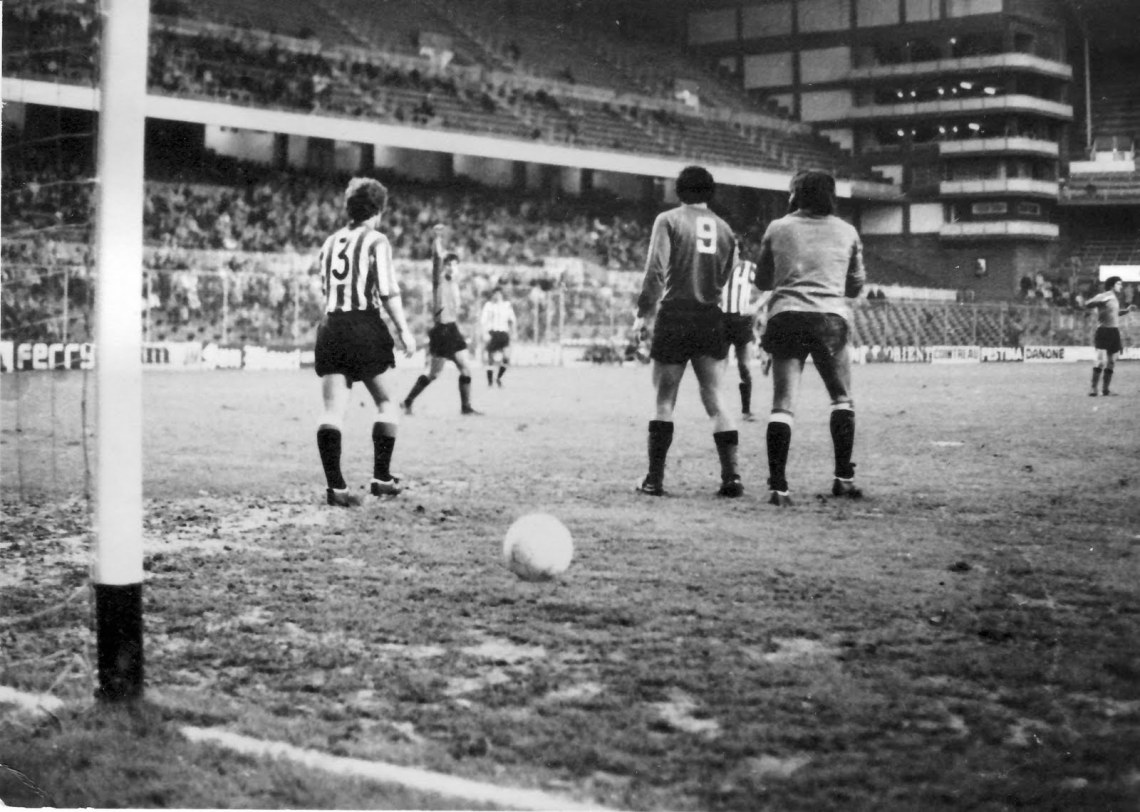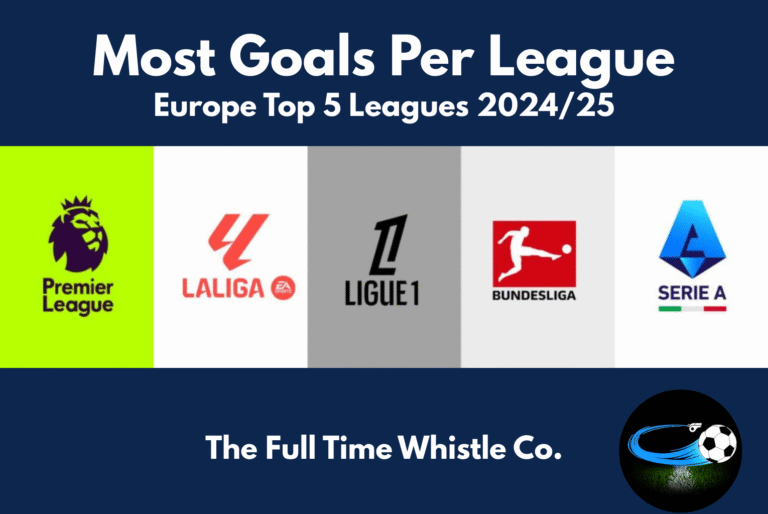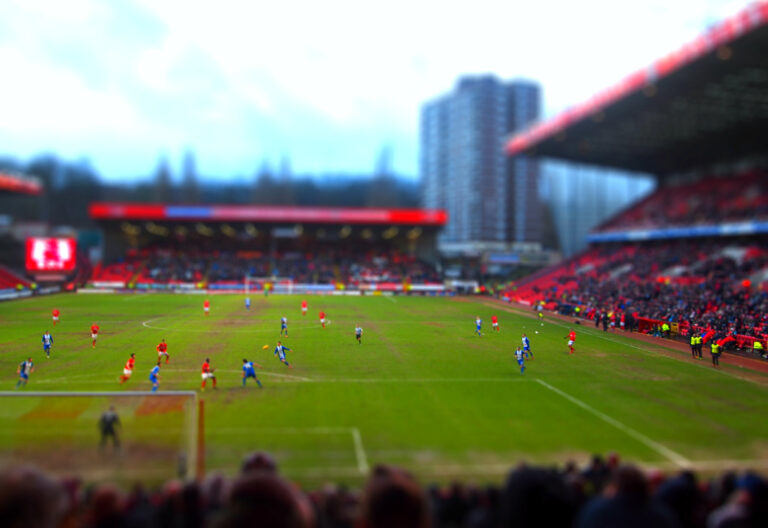
Football in Spain began just like it did in South America and Central Europe, it was introduced by the British and then took its own divergent path with a pervading Spanish twist and flavour but notwithstanding the influence of several Englishmen in the game’s infancy in the sunny fields of Espana.
The first recorded game in Spain was in 1887 between two teams consisting entirely of non-Spaniards which was recounted by historians as a match that represented the Brits reaching out to the Spanish through the camaraderie of sport but which according to historian Jimmy Burns, couldn’t have been farther from the truth. According to Burns, the game rather confirmed the stark differences between the English and Spanish:
“One can imagine the local crowd being unimpressed initially…. the game… lacked both the creativity and brinksmanship of the one popular local entertainment they could claim as their own.”
– Jimmy Burns
What Burns was referring to was bullfighting, which was, at the time, the main source of entertainment in Spain and so began the Spanish romance of bull fighting and football on a destiny that intertwined both the spectacles deeply within Spanish culture.
The Brits were primarily attracted to Spain, not just for the weather and the women but in mining pursuits and it was in Bilbao that the game really rallied and took hold. The first purpose-built football stadium in Spain was the San Mames which was built in Bilbao in 1913 and the region thus became the cradle of the Spanish game.
It was in Bilbao, a decade earlier in 1903 that Athletic Bilbao called ‘Athletic Club‘ in its inception, was formed by a merger of local teams in the area – A team of British players and local young Spanish players who had picked up the game while studying in England. Bilbao were first managed by an Englishman named Mr Shepherd but the club immediately issued a ruling which stipulated that only players of Basque descent could play for the club. However, the English and the game were held in high regard and the club looked to the Britons when it came to hiring their managers.

Billy Barnes
Shepherd was succeeded by Billy Barnes who famously scored the winner for Sheffield United in the 1902 FA Cup final and who went on to play for West Ham, Luton and QPR. Barnes won two Copa del Rey titles with Athletic Bilbao, then went back to Britain to sign up for service during WWI and then returned to the club in August 1920, only to find the Spaniards instilling their own version of the game at the club.
Writing about the Spanish game on his return in 1920, Barnes wrote:
“Basque football has progressed a lot since I was last here. When I first came, it was a patient slow game of short passing – elegant to watch but totally unpractical, Scots style. I introduced at Athletic a fast game with long passing, taking the ball from wing to wing, and fast players in the centre capable of scoring goals. Today I find most clubs have a tendency to play this way whereas Athletic seems to have lost its way.”
– Billy Barnes
The Beginnings Of ‘La Furia’

Spain tasted success in the international arena pretty soon. In the 1920 Olympic Games Athletic’s energetic approach was reified as the Spanish style. After beating Denmark 1-0 in their first game, Spain would go on to lose to Belgium 3-1 in the quarter finals but would enter a repechage system for the silver medal. The Spanish team’s chances of winning silver were boosted by Czechoslovakia being disqualified for storming off the pitch in protest of a British referee’s handling of their game. Subsequently, Spain then went on to beat Sweden 2-1, Italy 2-0 and in the final playoff for silver, beat the Netherlands 3-1 with Felix Sesumaga scoring twice.
However despite Sesumaga’s goals in the final playoff, another Basque player returned home as the hero. In the game against Sweden, Spain were trailing 1-0 at half time but six minutes into the second half equalised through Jose Maria Belauste. Two mintues later, Domingo Acedo netted the winner against the Swedes as the game ended 2-1 but it was Belauste’s goal that grabbed all the headlines, being described as ‘a Herculean goal‘ and one that summed up the Basque style of play.
As Manolo de Castro during the 1920 Olympics wrote:
“When play resumed after half time. Spain seemed to rally behind a call to battle and launched an attack of such ferocity that within two minutes it had secured a free-kick just outside the penalty area. Belauste launched himself at a chipped cross and took a number of Swedes with him as he bundled the ball into the net.”
– Manolo de Castro
The goal was romanticised, mythologised and exaggerated over time with legendary Spanish goalkeeper Ricardo Zamora later describing Belauste as carrying the ball into the net with ‘four Swedes clinging to his shirt‘.
The following day a Dutch newspaper compared Spain’s victory over Sweden to the ferocity of the Spanish troops that ransacked Antwerp in 1576, by coining the term ‘La Furia’, which the Spanish gladly adopted. And so began the Spanish way of playing, their own style of play, the Spanish ‘right way’ of playing, ‘La Furia’.
‘La Furia’ was defined by Jimmy Burns later as:
“A particularly muscular and aggressive style of football, blessed with nobility of intent and execution, over which the Basques at club level had already claimed a kind of copyright but which was absorbed into the broader national psyche.”
– Jimmy Burns
Pentland’s Bowler Hat, The Pichichi & The Coming Of Franco

However, another Englishman would lay the foundations that would form the basis of the modern Spanish game – tiki taka, et al during his stint as a manager in Spain. His name was Fred Pentland.
Pentland went on to coach Racing Santander and then Athletic Bilbao and he completely discarded the style of play instilled by Barnes in the 1920s. Pentland was a purist and more inclined to the Scottish ideology who focussed on doing the basics of the game right and assured the club after his appointment that ‘the rest would follow’.
It was there that he dismantled the long ball approach and instilled the short passing game, the foundation of the modern Spanish game which was still deeply rooted in ‘La Furia‘ but was a brand of football with more thought and less urgency.
Pentland was chidingly nicknamed ‘El Bombin‘ or ‘The Bowler‘ by his Bilbao players because of his trademark attire which included a bowler hat, which he rarely forgot to use. He was idiosyncratic and demanding and his Bilbao players would celebrate major victories by snatching his bowler hat and jumping on it until it was torn up into a rag.
Under Pentland, Bilbao won back to back Biscay titles and the 1923 Copa del Rey. According to legend, Pentland was heard shouting “Only three minutes left for you, bowler hat!” in the closing minutes of the 1923 Copa del Rey final.
Pentland would have stints at Real Oviedo and Atletico Madrid, called ‘Athletic Madrid‘ at the time, before returning to Bilbao again in 1929. He then shifted back to Madrid in 1933 but by that time he had led Bilbao to two La Liga titles, four further Copa del Rey titles, and three more Biscay trophies – and saw his Bilbao side demolish Barcelona 12-1 (still their record defeat of all time). Pentland then left Spain with the civil war approaching in 1936.
However, football continued in the country despite general Franco’s policies and attitudes towards Basques, which was rather complex. Despite him denouncing the Basques as a nation, he concurred with others in the Right that the roots of the ‘True Spain’ lay in the Basque country, bound up by Catholicism and notions of empire and survival against all odds.
Basques were considered Spain’s warrior class and it was in the Jesuit schools set up by the Basque knight Ignatius of Loyola(Also celebrated as the founder of my school St.Mary’s ICSE, here in Mumbai, India) that the values of sport, especially football, in building a student’s character were lauded and encouraged.

It was in one such Jesuit school that Rafael Moreno Aranzadi, better known as ‘pichichi’ or the ‘little duck‘ developed his love of football. He was a prolific striker for Athletic Bilbao and was part of the heroic Spanish side of the 1920 Olympics. Although there were more elements to his game than just scoring goals, Francoist Marca decided to name the La Liga top scorer award the ‘pichichi’ in his honour when they established the prize in 1953.
However, under Franco ‘la furia’ soon became ‘furia espanola’
As an editorial in the Falangist newspaper Arriba wrote in 1939:
The ‘furia espanola’ is present in all aspects of Spanish life, to a greater extent than ever. In sport, the ‘furia‘ best manifests itself in football, a game in which the virility of the Spanish race can find full expression, usually imposing itself, in international contests, over the more technical but less aggressive foreign teams.’
– Arriba (1939)
And so, as Jonathan Wilson writes, “Football, for Franco’s Spain as much as Mussolini’s Italy became a martial pursuit.”
Vittorio Pozzo – Il Vecchio (the Old Master)

In Italy the game took another sharp turn from the British game. The Italians adopted a formation which was in between the 2-3-5 and Herbert Chapman’s W-M but it was their ethos and philosophy that separated them from the brand of football being played in England and in Central Europe, the Danubian school.
The Italian game was described by British writer Brian Glanville as follows:
“Technically less brilliant than its European rival. Italian football ‘compensated…. by its greater forcefulness and the excellent physical condition of its players.’”
– Brian Glanville
The Italian game was pioneered by the bushy haired visionary Vittorio Pozzo who became, as Jonathan Wilson writes, the ‘presiding genius of inter-war Italian football‘.
Born near Turin in 1886, Pozzo was converted to football from running track and field after a friend of his, Giovanni Goccione(who would later play as a centre back for Juventus) mocked him for ‘running like a motor car‘ and suggested that he should try and run ‘with a ball at his feet‘.
Pozzo was no gifted player, but would spend time in academia in Zurich, Switzerland before moving to London in England where he fell in love with football and Manchester United. Accounts suggest, that Pozzo admired & was heavily influenced by the Red Devils midfield line(or half-back line as it was called then) of Dick Duckworth, Charlie Roberts and Alec Bell.
According to the story, Pozzo would hang out at the player’s exit area and would later befriend Roberts starting a long standing friendship with him. He held many formative discussions with the United half-back which would eventually lead to the tactics he deployed in his Italy sides of the later years.
Pozzo strongly disliked the third back game which was bubbling in England under Chapman at the time and like Roberts, he wanted his central midfielders or half-backs to play more with the ball and have a wide passing range that could spread play down each flank with long diagonals and incisively through the middle.
Upon his return to Italy, Pozzo was appointed ‘comisario tecnico’ for the 1912 Olympics. Italy lost narrowly to Finland and then beat Sweden, but were later thumped 5-1 by Austria. That was the first meeting between the Austrian pioneer Hugo Meisl and Pozzo. The pair would remain good friends off the pitch but were fierce rivals on the touchline in the coming years.
Pozzo stepped down during WWI but was reappointed as ‘comisario tecnico’ for the 1924 Olympics but stepped down again after his wife’s demise. He spent time as a director of Pirelli for the next five years before Italy came calling again in 1929. He would then guide Italy to glory for the next twenty years making them one of the strongest teams in Europe and arguably the best team in the world.
Il Modo Italiano – The Italian Way

Pozzo’s ideology was that of a cut-throat serial winner. He famously once said:
“It is a win at all costs. It is a bitter grudge against the adversary, it is a preoccupation of the result to the ends of the league table”
– Vittorio Pozzo
Pozzo was an Anglophile in the way he adopted the 2-3-5 but his vision for the centre half required a player who was not just astute defensively but also mobile and creative. Pozzo found him in Luisito Monti, who had played for Argentina at the 1930 World Cup. Monti joined Juventus in 1931 and became one of the initial ‘oriundi’ – the South American players, who thanks to their Italian heritage could play for their adopted country.
Monti quickly became a ‘Doble ancho’ (Double Wide) because of his capacity to cover serious ground over the pitch. Pozzo deployed Monti as the ‘centro mediano’ , the first complete central midfielder which evolved into the ‘sweeper‘ later in the game’s evolution. He would drop back in defence and mark the centre forward when his team were without the ball, and he would move higher up the pitch and orchestrate attacks as the fulcrum when his side were in possession.
Pozzo’s ‘sistema’ or ‘system’, as he called it, was different from the traditional ‘metodo’ or ‘method’. The shape was only fully understood and appreciated in Italy only in 1939 as a 2-3-2-3 or a W-W which Italian journalist Mario Zappa wrote in La Gazzetta dello Sport as:
“A model of play that is the synthesis of the best elements of all the most admired systems”
– Mario Zappa

That was the shape, but when it came to Italy’s style of play under Pozzo, it was essentially embedded deeply in his inherent pragmatism.
Giuseppe Meazza, The Birth Of Man Marking & The World Cups

The great Italian centre forward Giuseppe Meazza made his debut for Italy in 1930 and was regularly described and compared to a bullfighter – much to Spain’s dismay – while a popular song at the time had lyrics that went, ‘he scores to the rhythm of a foxtrot‘. Meazza remained a stylish forward but his combative nature and physicality fit perfectly into the Italian ‘sistema’.
Pozzo, meanwhile, as manager of Italy, was also one of the earliest exponents of man marking. The ploy finally reconciled football to not just being about a side concentrating on playing their own game but rather also about stopping the opposition playing theirs.
Pozzo famously said about his man marking strategy:
“If I succeed in cutting off the head with which the eleven adversaries thought, the whole system would collapse.”
– Vittorio Pozzo on Man-marking
It was however, in the heat of the 1934 World Cup that Pozzo’s tactics and strategy came under heavy scrutiny and criticism and really raised concerns about the ethics of his style of play.
It was Pozzo against Meisl as Italy played Austria in the semi-final at the ’34 World Cup but by then, the tournament had already boiled over into severe disrepute. Austria, under Meisl, were far from an innocent party after being involved in a brawl in their quarter-final win against Hungary while on the other side of the tournament ladder, Italy’s tactics in their 1-1 draw against Spain in their parallel quarter-final, marred the tournament in a similar vein with it’s violence.
Monti, the ‘centro mediano’ for all his brilliance and ability wasn’t afraid to partake in the darker arts of defending, while Spain’s goalkeeper Ricardo Zamora was clattered into, kicked and battered so badly by the Italians that he couldn’t play the replay the following day.
While sources vary as to whether three or four Spanish players had to leave the field through injury, a late diving header from who else but golden boy Meazza meant that Italy went through to the semis 1-0 with Spain defeated rather unjustly.
The stage was set for Pozzo’s Italy with their ‘sistema‘ against Meisl’s ‘Danubian school‘. It was meeting of two of football’s early pragmatists, in a game in which both sides cancelled each other out.
Austria’s great forward Matthais Sindelar was man marked by Monti and Austria failed to register a shot on target in the first forty minutes. Italy won by the one solitary goal after Meazza bundled into the Austrian keeper Platzer and Enrique Guaita, another of the oriundi, forced the ball across the line.
Italy then played Czechoslovakia in the final who took the lead in the seventy-sixth minute through Antonin Puc. However, with eight minutes left on the clock, Italy scored the equaliser through Orsi and then seven minutes into extra time a limping and slightly hindered Meazza crossed from the right, Guaita helped the ball on and Angelo Schiavio who later said that he was driven by ‘the strength of desperation’, scored the winner to give Pozzo and Italy their first World Cup on home soil.

Under Pozzo, Italy retained the World Cup again in 1938 with a team he described as his best ever side. It wasn’t a bad achievement, for a track and field protege, spurred on to the beautiful game by a sarcastic remark from his peer. He would then become one of Italian football’s greatest managers of all time.
Pozzo’s Tainted Legacy
But, Pozzo’s achievements as impressive as they were, were wiped out of Italian history on purpose because of his links to Mussolini. While the extent of Pozzo’s involvement with Mussolini’s regime remains unclear, it led to him being deliberately shunned in the 50s and 60s. In later years, before the 1990 World Cup in Italy, it led to the stadium built just outside Turin for that iconic World Cup, the Stadio delle Alpi, being named as it was instead of being named after Pozzo.
However, in the years following the 1990 World Cup evidence emerged to suggest that he had worked with the anti-fascist resistance in Italy and helped Allied prisoners of war escape. Nevertheless, he remains a controversial figure in Italian football.
The Coffee House & The Wunderteam
Back in Austria football boomed in the 1920s. Before the Spaniards and the Italians, Hugo Meisl and Jimmy Hogan(covered in part II) brought about the football revolution in the country. Whilst the game in England was discussed in pubs across the country, in Austria, the discussions about football took place in coffee houses centred around Vienna, and later, the same coffee house culture spread to Budapest and Prague.
In fact, the coffee house became a hotbed for cultural mixing and debate. There were thinkers, pioneers, artists, politicians, and people from all social classes, playing cards and chess, sipping coffee, reading newspapers and smoking cigarettes and almost inevitably they gravitated to discussing football which was becoming rapidly popular amongst the working class and middle class in Austria. It must be noted however, that it remained mostly an urban phenomenon.
Austria boasted its own football superstars of the time, Rapid’s Joesph Uridil and Austria Vienna’s Matthais Sindelar both centre forwards, Uridil more physical and brutish while Sindelar was described as a ‘thinker’ who was ‘gifted’ and ‘cerebral’.

For the national side managed by Meisl, the Austrian tactician gave Sindelar his debut as a twenty-three-year-old in 1926 but preferred playing Uridil who slotted well into his conservative approach. However, finally in 1931, Meisl decided to field Sindelar instead, and the results were almost instantaneous. Austria drubbed Scotland 5-0 just two and a half years after the Scots thrashed England 5-1 at Wembley, with that Scottish team dubbed soon after as the ‘Wembley Wizards‘.
Sindelar was instrumental in all of Austria’s attacking play, everything seemed to run through him and soon the team with him at the apex, with the ‘Wembley Wizards‘ vanquished, came to be known as the ‘Wunderteam‘. The coffee houses celebrated the Wunderteam and in Sindelar they saw a man born from same bohemian Viennese flesh and blood and they soon adopted him as their own.
The Wunderteam played a strict 2-3-5 under Meisl and won nine and drew two of their next eleven games winning the second instalment of the Dr. Gero Cup and in the process becoming Austria’s pride.
It has to be noted, however, that the Viennese coffee house culture comprised, by and large, of a predominantly Jewish section of Austrian and Hungarian bourgeoisie, which then eventually ended with the coming of the Nazis.
German Football’s Development Years & How Football Became A Propaganda Tool For Fascism
With Sindelar reaching the end of his career and Meisl ageing as well, the Danubian school and the era of the Wunderteam would have faded out with time anyway, but the rise of fascism ensured it would do so at an accelerated rate.
Franco had the ‘furia espanola’ and to an extent, it was the spirit of his dictatorship, promoted as part of the propaganda of Franco’s New Spain, while in Italy, Mussolini got the World Cup victories he desired under Pozzo, and by the time of his third coming, the fascist government in Italia recognised the utility of sport as a propaganda tool and began investing heavily in stadiums and infrastructure.
In Germany meanwhile, professional football came into fruition much later as compared to the rest of Europe. The game in Germany wasn’t as advanced as Austria but it was improving and Otto Nerz was appointed as Germany’s first coach on July 1 1926.
The journeyman Jimmy Hogan would have his role to play in German football history in the years leading up to 1926 after being appointed as coach of SC Dresden. Hogan reportedly undertook a lecture tour in one month alone speaking to nearly 5,000 footballers in the Dresden area.

However, after rising tensions and fears about the political situation, Hogan left Germany for Paris and then finally returned back to Austria to work with his old time friend Hugo Meisl.
When Hogan died in 1974, the German Football Federation(DFB) wrote to Hogan’s son calling Hogan the founder of ‘modern football’ in Germany.
Nevertheless, history took its course and Hitler and the Nazis plunged Europe into turmoil.
Germany were semi-finalists at the 1934 World Cup which encouraged beliefs that they might go on to win gold on home turf at the 1936 Olympics. But instead they lost 2-0 to Norway rather humiliatingly and rather more historically speaking, it was the only football match Hitler ever attended.
Germany would break the shackles and become a force to be reckoned with on the world stage in the second half of the 20th century.
But suddenly, football became more than a game, and the fascist regimes of Europe during that period of time thrived on the success of their respective countries on the pitch in the years leading up to WWII using the sport’s widespread reach, interest and influence to strengthen their positions in power and implement personal ideals and national policies.



